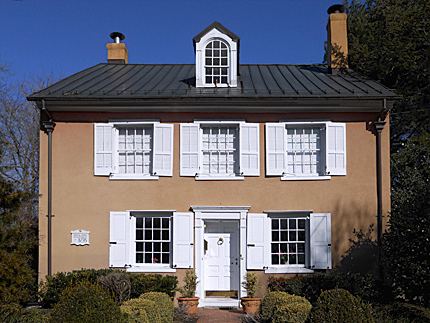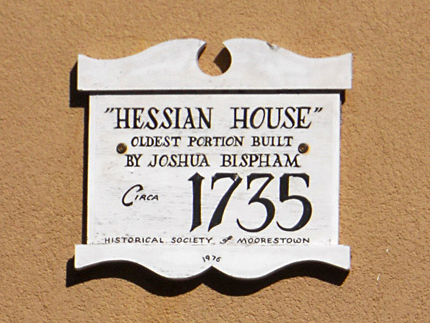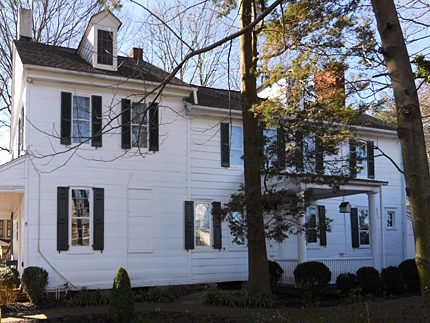


Moorestown Friends Meeting House
Main St. and Chester Ave.
Map / Directions to the Moorestown Friends Meeting House
Map / Directions to all Moorestown Revolutionary War Sites
The current Moorestown Meeting House stands on Main Street. It was built in 1802, replacing a 1720 stone building which stood on the other side of Main Street. The site of the 1720 stone building, as well as an even earlier 1700 log meeting house, is marked in the field across Main Street which contains the Moorestown Friends Cemetery.
Although the sign does not mention it, Hessian troops encamped on the grounds of the Meeting House from June 19 - 21, 1778, during the movement of British and Hessian forces across New Jersey from Philadelphia to New York City. (Hessians were mercenary soldiers hired by the British to fight on their side in the Revolutionary War.)
During these same days, British troops under General Henry Clinton were encamped several miles from here, first in Mount Laurel and then in Mount Holly. [1]
Nine days later, on June 28, the Battle of Monmouth was fought.



Hessian House
Main St.
Map / Directions to the Hessian House
Map / Directions to all Moorestown Revolutionary War Sites
This house is a private residence.
Please respect the privacy and property of the owners.
This is known as the Hessian House because it was commandeered by Hessian officers during the Hessian encampment in Moorestown in June 1778 (see above entry). [2]



Smith-Cadbury Mansion
12 High St.
Map / Directions to the Smith-Cadbury House
Map / Directions to all Moorestown Revolutionary War Sites
Now the headquarters of the Historical Society of Moorestown.
Visit their website for more information and current visiting hours.

1. ^ The following letters between American officers, which can be read on the National Archives website, describe the British in Moorestown during this time period:
“To George Washington from Major General Philemon Dickinson, 20 June 1778,” Founders Online, National Archives (http://founders.archives.gov/documents/Washington/03-15-02-0498 [last update: 2015-06-29]). Source: The Papers of George Washington, Revolutionary War Series, vol. 15, May–June 1778, ed. Edward G. Lengel. Charlottesville: University of Virginia Press, 2006, pp. 479–480.
“From George Washington to Major General Benedict Arnold, 21 June 1778,” Founders Online, National Archives (http://founders.archives.gov/documents/Washington/03-15-02-0507 [last update: 2015-06-29]). Source: The Papers of George Washington, Revolutionary War Series, vol. 15, May–June 1778, ed. Edward G. Lengel. Charlottesville: University of Virginia Press, 2006, p. 487.
“To George Washington from Major General Philemon Dickinson, 21 June 1778,” Founders Online, National Archives (http://founders.archives.gov/documents/Washington/03-15-02-0508 [last update: 2015-06-29]). Source: The Papers of George Washington, Revolutionary War Series, vol. 15, May–June 1778, ed. Edward G. Lengel. Charlottesville: University of Virginia Press, 2006, pp. 487–488.
“To George Washington from Major General Benedict Arnold, 21 June 1778,” Founders Online, National Archives (http://founders.archives.gov/documents/Washington/03-15-02-0506 [last update: 2015-06-29]). Source: The Papers of George Washington, Revolutionary War Series, vol. 15, May–June 1778, ed. Edward G. Lengel. Charlottesville: University of Virginia Press, 2006, pp. 485–486.
(See specifically the "enclosed letter from Howell to Maxwell" shown in the footnote)“To George Washington from Major General Philemon Dickinson, 22 June 1778,” Founders Online, National Archives (http://founders.archives.gov/documents/Washington/03-15-02-0517 [last update: 2015-06-29]). Source: The Papers of George Washington, Revolutionary War Series, vol. 15, May–June 1778, ed. Edward G. Lengel. Charlottesville: University of Virginia Press, 2006, p. 496.
“From George Washington to Henry Laurens, 22 June 1778,” Founders Online, National Archives (http://founders.archives.gov/documents/Washington/03-15-02-0523 [last update: 2015-06-29]). Source: The Papers of George Washington, Revolutionary War Series, vol. 15, May–June 1778, ed. Edward G. Lengel. Charlottesville: University of Virginia Press, 2006, pp. 505–506.
2. ^ The Historical Society of Moorestown plaque on the house (erected 1976) states "oldest portion built by Joshua Bispham circa 1735."
However, the information in the two following genealogical works state that Joshua Bispham did not immigrate to America from England until after 1735, arriving in Philadelphia April 26, 1737, and moved to Moorestown in 1743:
William Bispham, Memoranda Concerning the Family of Bispham in Great Britain and the United States of America (New York: Privately Printed, 1890) beginning at page 257
Available to be read at Google Books hereJohn W. Jordan, Colonial And Revolutionary Families Of Pennsylvania (Originally published New York and Chicago, 1911, Reprinted for Clearfield Company, Inc. by Genealogical Publishing Co., Inc, Baltimore, MD, 1994, 2004) page 654
Available to be read at Google Books here